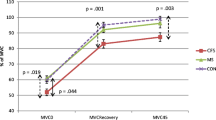Abstract
Chronic fatigue syndrome (CFS) is generally considered to be a women's health issue, but the illness occurs also in men. The research objective of this study was to determine if illness patterns and functional status differed between the sexes. Because our own data showed that women with CFS have significantly more comorbid fibromyalgia or multiple chemical sensitivity than men, we eliminated patients with these comorbid conditions from our evaluation. Women with CFS were quite similar to men with CFS in terms of demographics, psychiatric status, functional status, and assessments of disability. Women reported more infectious/flu-like symptoms (represented by a factor derived from factor analysis) than men, but these differences were insignificant after controlling for other variables. Cluster analysis revealed that women were more likely than men to fall in the cluster characterized by symptom severity. Differences found were those of degree rather than of type; strikingly different illness patterns—suggestive of different pathophysiological processes between the sexes—were not found.
Similar content being viewed by others
REFERENCES
Abbey, S. E., & Garfinkel, P. E. (1991). Chronic fatigue syndrome and depression: Cause, effect, or covariate. Reviews of Infectious Diseases, 13(Suppl. 1), 73-83.
Beck, A. T., Ward, C. M., Mendelsohn, M., Mock, J., & Erbaugh, M. (1961). An inventory for measuring depression. Archives of General Psychiatry, 5, 561-571.
Brimacombe, M., Helmer, D., & Natelson, B. H. (2002). Clinical differences exist between patients fulfilling the 1988 and 1994 case definitions of chronic fatigue syndrome. Journal of Clinical Psycology in Medical Settings, 9, 309-314.
Buchwald, D., Pearlman, T., Kith, P., & Schmaling, K. (1994). Gender differences in patients with chronic fatigue syndrome. Journal of General Internal Medicine, 9, 397-401.
Ciccone, D. S., & Natelson, B. H. (2003). Comorbid illness in the chronic fatigue syndrome: A test of the single syndrome hypothesis. Psychosomatic Medicine, 62, 268-275.
Friedberg, F. (2000). A subgroup analysis of cognitive–behavioral treatment studies. Journal of Chronic Fatigue Syndrome, 5, 149-159.
Fukuda, K., Straus, S. E., Hickie, I., Sharpe, M. C., Komaroff, A., Schluederberg, A., et al. (1994). The chronic fatigue syndrome: A comprehensive approach to its definition and study. Annals of Internal Medicine, 121, 953-959.
Hamblin, T. J. (1990). Interleukin 2: Side effects are acceptable. BMJ, 300, 275-276.
Hickie, I., Lloyd, A., Hadzi-Pavlovic, D., Parker, G., Bird, K., & Wakefield, D. (1995). Can chronic fatigue syndrome be defined by distinct clinical features? Psychological Medicine, 25, 925-935.
Holmes, G. P., Kaplan, J. E., Gantz, N. M., Komaroff, A. L., Schonberger, L. B., Straus, S. E., et al. (1988). Chronic fatigue syndrome: A working case definition. Annals of Internal Medicine, 108, 387-389.
Jason, L. A., Richman, J. A., Rademaker, A. W., Jordan, K. M., Plioplys, A. V., Taylor, R. R., et al. (1999). A community-based study of chronic fatigue syndrome. Archives of Internal Medicine, 159, 2129-2137.
Jason, L. A., Taylor, R. R., Kennedy, C. L., Jordan, K. M., Song, S., Johnson, D., et al. (2003). Chronic fatigue syndrome: Symptom subtypes in a community based sample. Women and Health, 37, 1-13.
Lindal, E., Stefánsson, J. G., & Bergman, S. (2002). The prevalence of chronic fatigue syndrome in Iceland—A national comparison by gender and 4 different criteria. Nordic Journal of Psychiatry, 56, 273-277.
Pollet, C., Natelson, B. H., Lange, G., Tiersky, L., DeLuca, J., Policastro, T., et al. (1998). Medical evaluation of Persian Gulf veterans with fatigue and/or chemical sensitivity. Journal of Medicine, 29, 101-113.
Reyes, M., Nisenbaum, R., Hoaglin, D. C., Unger, E. R., Emmons, C., Randall, C., et al. (2003). Prevalence and incidence of chronic fatigue syndrome in Wichita, Kansas. Archives of Internal Medicine, 163, 1530-1536.
SAS (1999). SAS/STAT User's Guide (Version 8, Vol. 1). Cary, NC: SAS Institute Inc.
Schluederberg, A., Straus, S. E., Peterson, P., Blumenthal, S., Komaroff, A. L., Spring, S. B., et al. (1992). Chronic fatigue syndrome research. Definition and medical outcome assessment. Annals of Internal Medicine, 117, 325-331.
Smets, E. M. A., Garssen, B., Bonke, B., & De Haes, J. C. J. M. (1995). The multidimensional fatigue inventory (MFI) psychometric qualties of an instrument to assess fatigue. Journal of Psychosomatic Research, 39, 315-325.
Ware, J. E., Jr., Snow, K. K., Kosinski, M., & Gandek, B. (1993). SF-36 health survey. Manual and interpretation guide (1st ed.). Boston: The Health Institute, New England Medical Center.
Wessely, S., Chalder, T., Hirsch, S., Wallace, P., & Wright, D. (1997). The prevalence and morbidity of chronic fatigue and chronic fatigue syndrome: A prospective primary care study. American Journal of Public Health, 87, 1449-1455.
White, K. P., Speechley, M., Harth, M., & Ostbye, T. (1999). The London fibromyalgia epidemiology study: The prevalence of fibromyalgia syndrome in London, Ontario. Journal of Rheumatology, 26, 1570-1576.
Wolfe, F., Smythe, H. A., Yunus, M. B., Bennett, R. M., Bombardier, C., Goldenberg, D. L., et al. (1990). The American College of Rheumatology 1990 criteria for the classification of fibromyalgia: Report of the Multicenter Criteria Committee. Arthritis and Rheumatism, 33, 160-172.
Author information
Authors and Affiliations
Corresponding author
Rights and permissions
About this article
Cite this article
Tseng, CL., Natelson, B.H. Few Gender Differences Exist Between Women and Men with Chronic Fatigue Syndrome. Journal of Clinical Psychology in Medical Settings 11, 55–62 (2004). https://doi.org/10.1023/B:JOCS.0000016270.13052.cf
Issue Date:
DOI: https://doi.org/10.1023/B:JOCS.0000016270.13052.cf




